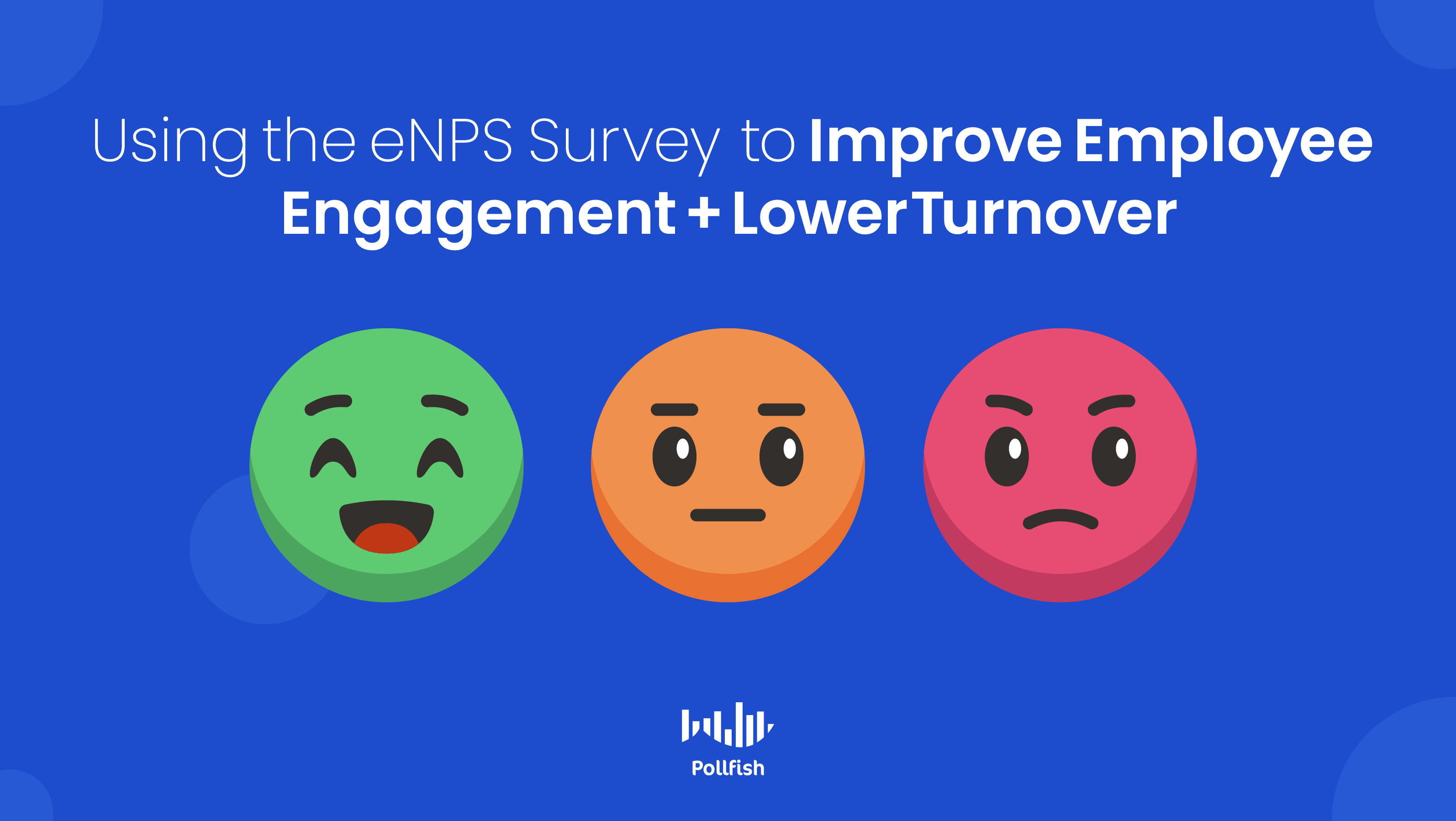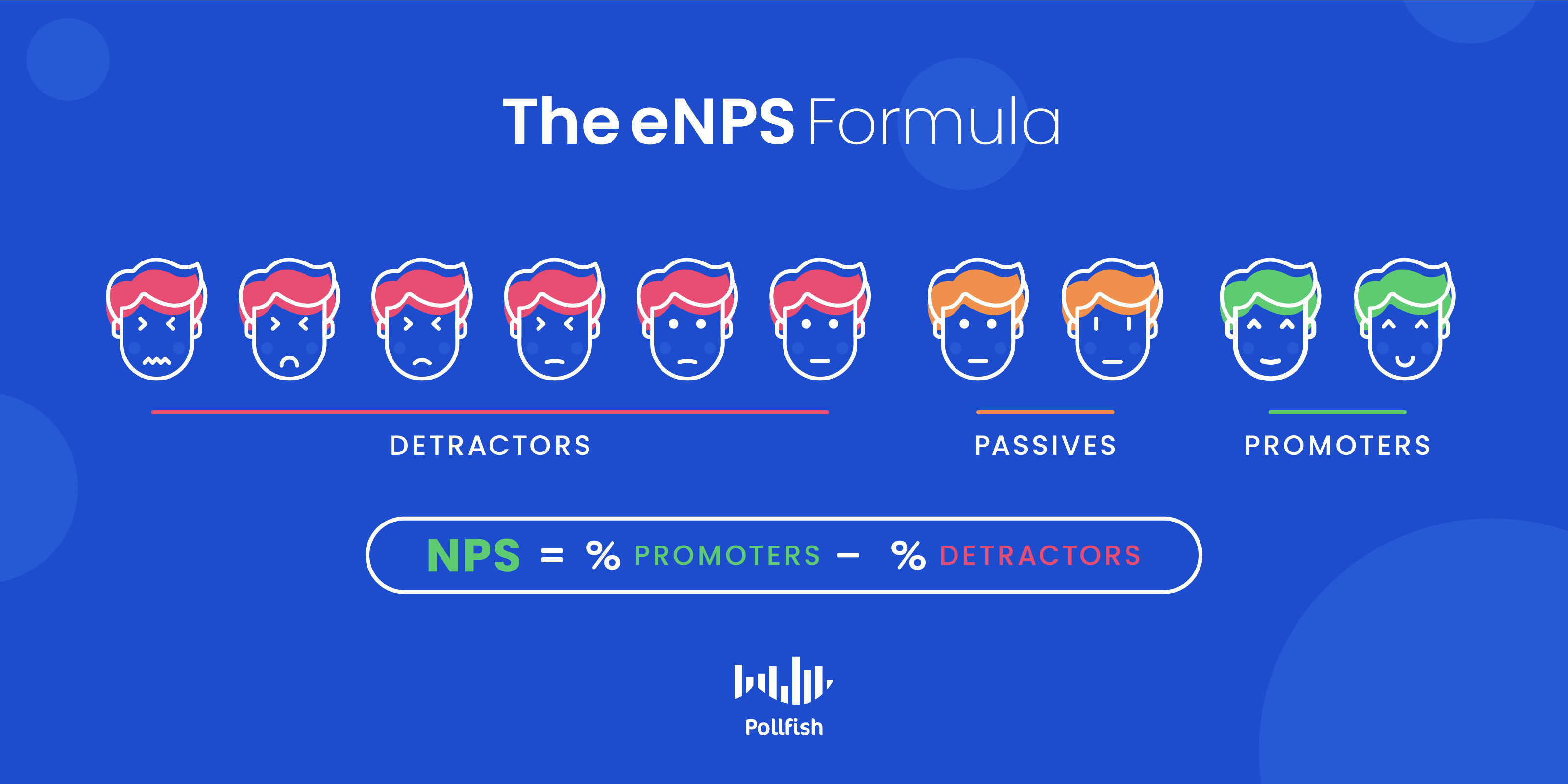Diving into the eNPS Survey to Improve Employee Engagement and Performance

The eNPS survey, a shortened form of the Employee Engagement Survey, is a practical method for measuring employee engagement and employee satisfaction.
Employee engagement is not merely useful for lifting morale but it also yields positive business outcomes. Not only do engaged employees outperform their non-engaged counterparts, but companies with high employee engagement are 21% more profitable.
Companies with higher employee engagement also succeed in a number of other fronts. Businesses with higher employee engagement have 18% higher sales productivity and 18% less turnover.
Despite these figures, only 36% of employees are engaged in their workplace. Evidently, there is a disconnect between businesses and employees. Companies can turn this bleak statistic around, by better understanding their employees with the eNPS survey.
This article explains the eNPS survey, its importance, calculation, examples and more.
Understanding the eNPS Survey
This kind of survey is based on the premise of the NPS (Net Promoter Survey), but in relation to employees, hence its name. Designed to measure employee loyalty, this survey is a technique for gauging how willing employees are to recommend their workplace to their friends, family or peers.
While the NPS survey measures customer loyalty, the eNPS survey measures employee loyalty, and does so in the same manner — by way of asking the “ultimate question” and by implementing a scaled response, using a scale of 1-10.
The “ultimate question” is poised in the same way, but rather than focus on the company, the products or services, it focuses the inquiry in relation to the employer. Here is an example of the “ultimate question” for the eNPS survey:
On a scale of 1-10, how likely are you to recommend working at your company to a friend or acquaintance?
A few other examples:
- On a scale of 1-10, how likely are you to recommend your employer to a friend or acquaintance?
- On a scale of 1-10, how likely are you to recommend our organization/company to a friend or acquaintance?
- Considering your complete experience, how likely are you to recommend our company to a friend or acquaintance?
When employees answer this core question of the eNPS survey, their response is then tallied as an eNPS score, which reveals the sentiment and consequences behind the employees’ answers. This kind of survey has various benefits.
The Importance and Benefits of the eNPS Survey
The eNPS survey is critical for businesses of all sizes to conduct and offers various benefits. The foremost importance that this kind of survey carries is that it gives businesses a quick and easy way of obtaining an overview of employee engagement and loyalty.
This survey further reveals how much of an employee pool is content and how much of it isn’t. Therefore, it highlights which employees are happy and which aren’t, along with how to begin implementing changes for a more engaged workplace.
This survey can also be used as a time measurement metric to see how various changes throughout a quarter, year or another period of time affected employee engagement.
The Employee Net Promoter Score Survey has various benefits, such as its short format that requires little to no time from the employees to complete. It can also be expanded with follow-up questions for a more in-depth understanding of the reason behind their score. Thus, this survey allows businesses to understand why employees feel the way they do about their companies and allows them to improve on this front.
It is also simple to create and deploy, though this benefit will depend on the online survey platform businesses use.
The shortness and simplicity of this kind of survey wards off survey fatigue and prevents survey attrition. It is also easy to calculate the results and to use them for actionable insights, along with benchmarking and setting goals to manage employee engagement.
Due to the relative ease of creating this kind of survey, drawing conclusions from its single metric and its ease of participation — it is practical to apply it at continuous intervals.
All in all, the eNPS survey is a succinct and simple way of calculating a critical component of a business: its employee engagement. Understanding the levels of engagement within a workforce allows businesses to understand the reasons behind employee performance, how to improve their engagement and in turn, pave the way for employee loyalty.
How to Calculate the eNPS and its Numerical Significance
As explained in a previous section, the eNPS survey is based on its eponymous eNPS score, which is derived from a scale of 0-10 on the “ultimate question.”
After an employee answers this question based on a number on this scale, their score categorizes them as one of the three eNPS categories: the detractors, passives and promoters.
These categories represent the kinds of employees a business’s employees fall under in terms of their engagement and satisfaction with their company. Each category is based on a rang of scores, rather than just one.
The following explains the three types of eNPS employee categories:
 The Detractors
The Detractors
- Score from 0-6
- Highly dissatisfied employees
- Risk spreading negative feedback about a company
- Businesses should avoid these the most
- Businesses must work the most diligently to improve detractors’ engagement and satisfaction with their business, or else they may burnout, quit and write poor reviews.
The Passives
- Score from 7-8
- They bear neither negative nor positive feelings towards their employer
- Considered mid-range in terms of their feelings towards recommending thor company
- They are neither emotionally invested nor disengaged
- Passives require a little push to raise their satisfaction and engagement levels. They may leave lukewarm comments about their employer.
The Promoters
- Score from 9-10
- Highly satisfied and engaged employees
- They spread positive feedback about their company
- These are the most coveted employees
- These employees can become company advocates and improve the reputation of any company.
The eNPS Formula
The eNPS score is never based on one employee. Rather, it is a calculation of all the employees who took part in the survey.
As such, an eNPS score can range from -100 to 100. Scores above zero are considered decent, although company standards will vary. Generally, a score of 10-30 is considered good, and a score of 50 is excellent.
Researchers must first determine the kinds of employees that their survey respondents fall under based on the three categories of detractors, passives and promoters. Then, they can calculate their eNPS based on a particular survey study.

The employee Net Promoter Score uses the following calculation: the number of promoters minus the number of detractors, divided by the total number of respondents, which is thn multiplied by 100.
Ignore the passives, as they are considered neutral.
Therefore the eNPS formula is expressed as:
eNPS= (No. of Promoters – No. of Detractors) / Total Number of Respondents x 100
For example, in a company of 100 employees, 25 rated the company a 9 or 10 (they’re the promoters), 52 rated the company between 0 to 6 (they’re the detractors). Thus, the calculation becomes:
25- 52 = – 27
-27/ 100 = -0.27
-0.27 x 100 = -27%
-27 is a poor score as it is well under 0; businesses should aim to score at 30, or above 0 at the very least.
Using Survey Research to Improve the eNPS Survey Results
Regardless of its eNPS score, a business must look beyond this kind of survey to understand the reasons why employees feel a certain way towards their companies.
To remain in good keeping with employees in general, business owners should conduct an employee feedback survey regularly.
Specifically, they ought to run a pulse survey to understand their employees’ sentiments, along with those of their customers and vendors. All of these players are key to sustaining a business, so they must be catered to properly. In order to do that, a business should understand all of their pain points, needs, desires and anything else that relates back to a business.
Survey research provides a strong vehicle for extracting all of these insights and not just on a quantitative basis. Surveys can provide qualitative market research, the kind that provides context and reasoning behind respondents’ answers.
Even in an eNPS survey itself, this survey can provide more than just a means for calculating the eNPS score, as businesses can use it to ask follow-up questions. These include open-ended questions that allow businesses to learn why a respondent answered in a particular way, or provided a particular score of 0-10.
Therefore, other employee surveys, such as those aforementioned, provide keen insight into the minds of employees (and customers). Access to this kind of information enables businesses to make informed decisions and effect critical changes, the kinds that improve employees’ perceptions of their employers/companies and make them more inclined to stay with their company.
In this way, survey research can improve workplaces, cut back on turnover and maintain a positive reputation of a business, especially in terms of its employee relations and general work environment.
Improving Employee Relations and Creating a Positive Work Environment
Data is vital for assessing employee engagement and perceptions at large.
Surveys allow businesses to unearth all kinds of employee perceptions in relation to a company — the kinds they would otherwise not know about. A strong online survey platform can help obtain this kind of information, along with deploying it.
There are virtually no other competent means for obtaining employee feedback in such a quick and anonymous way. One-on-one interviews, for example, are not as useful as surveys, as they strip away the anonymous element, leaving employees unable to answer as honestly as they could. These interviews are also more time-consuming than surveys.
A strong online survey platform offers a powerful solution for creating and administering an eNPS survey and facilitating survey research in general. Such a platform can carry out a vast amount of customer and employee research, allowing businesses access to critical data on many fronts. A strong online survey platform should also include artificial intelligence and quality checks, so that businesses and market researchers only get the finest quality of data.
Pollfish Marketing Team
Ready to Try Pollfish?
Create your survey with AI, target high-quality respondents starting at $0.95 per complete, and start getting results in just minutes in real-time. From running a simple product concept survey to managing a constant stream of trackers for dozens of clients in dozens of countries, we’ve got you.

 The Detractors
The Detractors